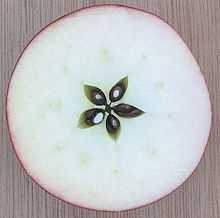- Symmetry in biology
-
For other uses, see Symmetry (disambiguation) and Bilateral (disambiguation).
- "Bilateral symmetry" redirects here. For bilateral symmetry in mathematics, see reflection symmetry.
Symmetry in biology is the balanced distribution of duplicate body parts or shapes. The body plans of most multicellular organisms exhibit some form of symmetry, either radial symmetry or bilateral symmetry or "spherical symmetry". A small minority exhibit no symmetry (are asymmetric).
In nature and biology, symmetry is approximate. For example, plant leaves, while considered symmetric, will rarely match up exactly when folded in half.
Contents
Radial symmetry
These organisms resemble a pie where several cutting planes produce roughly identical pieces. An organism with radial symmetry exhibits no left or right sides. They have a top and a bottom (dorsal and ventral surface) only.
Animals
Symmetry is important in the taxonomy of animals; animals with radial symmetry are classified in the taxon Radiata, which is generally accepted to be a clade of the kingdom Animalia. Most radially symmetric animals are symmetrical about an axis extending from the center of the oral surface, which contains the mouth, to the center of the opposite, or aboral, end. This type of symmetry is especially suitable for sessile animals such as the sea anemone, floating animals such as jellyfish, and slow moving organisms such as sea stars (see special forms of radial symmetry). Animals in the phyla cnidaria and echinodermata exhibit radial symmetry (although many sea anemones and some corals exhibit bilateral symmetry defined by a single structure, the siphonoglyph) (see Willmer, 1990). The echinodermata, however, exhibit bilateral symmetry in their larvae, and are thus classed as bilaterians.
Plants
Many flowers and plants are radially symmetric (also known as actinomorphic). Roughly identical petals, sepals, and stamen occur at regular intervals around the center of the flower. Cases where otherwise cylindrical plant shapes are transformed into helices are described by the term helical growth.
Special forms of radial symmetry
Tetramerism
Many jellyfish have four canals and thus exhibit tetramerous radial symmetry. This form of radial symmetry means it can be divided into 4 equal parts.
Pentamerism
This variant of radial symmetry (also called pentaradial and pentagonal symmetry) arranges roughly equal parts around a central axis at orientations of 72° apart.
- Animals
Members of the phylum Echinodermata (such as sea stars, sea urchins, and sea lilies) have parts arranged around the axis of the mouth in five equal sectors. Being bilaterian animals, however, they initially develop biradially as larvae, then gain pentaradial symmetry later on. The radiolarians demonstrate a remarkable array of pentameric forms. Examples include the Pentaspheridae, the Pentinastrum group of general in the Euchitoniidae, and Cicorrhegma (Circoporidae).
- Plants
Flowering plants demonstrate symmetry of five more frequently than any other form.
Around 1510–1516 A.D., Leonardo da Vinci determined that in many plants a sixth leaf stands above the first. This arrangement later became known as 2/5 phyllotaxy, a system where repetitions of five leaves occur in two turns of the axis. This is the most common of all patterns of leaf arrangement.
Various fruits also demonstrate pentamerism, a good example of which is seen in the arrangement of the seed carpels in an apple.
Hexamerism and octamerism
Corals and sea anemones (class Anthozoa) are divided into two groups based on their symmetry. The most common corals in the subclass Hexacorallia have a hexameric body plan; their polyps have sixfold internal symmetry and the number of their tentacles is a multiple of six.
Corals belonging to the subclass Octocorallia have polyps with eight tentacles and octameric radial symmetry.
Spherical symmetry
Spherical symmetry occurs in an organism if it is able to be cut into two identical halves through any cut that runs through the organism's center.[citation needed]
Biradial symmetry
Biradial is a combination of radial and bilateral symmetry. Ctenophores exhibit biradial symmetry. Some of the phyla formerly classified as aschelminth have anterior and radial portions.[1]
In this type of symmetry, the body components of an animal are arranged such that similar parts are located to either side of a central axis and each of the four sides of the body is identical to the opposite side but different from the adjacent side.
Bilateral symmetry
In bilateral symmetry (also called plane symmetry), only one plane, called the sagittal plane, will divide an organism into roughly mirror image halves (with respect to external appearance only, see situs solitus). Thus there is approximate reflection symmetry. Often the two halves can meaningfully be referred to as the right and left halves, e.g. in the case of an animal with a main direction of motion in the plane of symmetry.
Animals
Animals that are bilaterally symmetric are put in the group Bilateria. Bilateral symmetry means capable of being split into two equal parts so that one part is a mirror image of the other. The plane of symmetry lies dorso-ventrally and anterior-posteriorly.
Most animals are bilaterally symmetric, including humans (see also facial symmetry). The oldest known bilateral animal is the Vernanimalcula. Most bilateral animals have an identical shape on either side, as if bisected by a mirror. Bilateral symmetry permits streamlining, favors the formation of a central nerve center, contributes to cephalization, and promotes actively moving organisms. Bilateral symmetry is an aspect of both chordates and vertebrates.
One unique animal in the group Bilateria is the phylum Echinodermata which includes starfish, sea urchin and sand dollars. All these animals show bilateral symmetry in their larval stage, but pentalateral symmetry (a special type of radial symmetry) as adults.
Bilateral symmetry is not easily broken. In experiments using the fruit fly, Drosophila, in contrast of other traits (where laboratory selection experiments always yield a change), right or left-sidedness in eye size, or eye facet number, wing-folding behavior (left over right) show a lack of response. [2]
Plants
Flowers such as members of the orchid and pea families are bilaterally symmetrical (also known as zygomorphic). The leaves of most plants are also superficially bilaterally symmetrical. A careful examination of leaf vein patterns often shows imperfect bilateral symmetry. Also, the pattern of leaves on a branch or stem may often show glide symmetry, with left, right alternation, rather than perfect bilateral symmetry. Cases where otherwise bilateral plant organs are transformed into seemingly helical shapes are known under the term helical growth.
Asymmetry
The notable exception among animals is the phylum Porifera (sponges) which have no symmetry. The approximately 400 species of flatfish also lack symmetry as adults, though the larvae are bilaterally symmetrical.
See also
- Floral symmetry
- Supernumerary body part
- Organisms
References
- ^ Development of radial and biradial symmetry
- ^ http://www.biology.ualberta.ca/palmer/asym/axes/symmetry.htm
- Fact Monster
- Heads, Michael. "Principia Botanica: Croizat's Contribution to Botany." Tuatara 27.1 (1984): 26-48.
- Zoology a website by the Monaco educational service
- Willmer, P. G. (1990). Invertebrate Relationships : Patterns in Animal Evolution. Cambridge University Press, Cambridge.
External links
- Live Science.com article called "Symmetry in Nature: Fundamental Fact or Human Bias?" By Ker Than
- Evolutionary Theories of Asymmetrization of Organisms, Brain and Body
Categories:- Symmetry
- Developmental biology
- Animal anatomy
Wikimedia Foundation. 2010.




